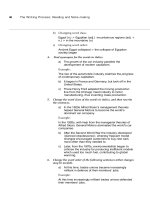Dudley j towards safer ships cleaner seas a handbook for modern tankship operations 1994 ISBN 82 90344 06 6
Bạn đang xem bản rút gọn của tài liệu. Xem và tải ngay bản đầy đủ của tài liệu tại đây (30.57 MB, 550 trang )
10-002 Towards safer Ship & Cleaner Seas
FIGURES AND ILLUSTRATIONS
Chapter 1. Serving as an officer on a tanker
1.3.5 Officer hand-over notes - use of bound journal
43
1.4.1 Station bill - example of fire and abandon ship emergency plan
44
1.4.4 Drills - conduct of drills for best results
46
1.4.5 Verbal drills - verbal drills of possible incidents improve readiness 47
1.5.1 Crew training records - proof or training received
50
1.6.2 Officer’s deck notebook - example of clean product tanker loading plan
58
1.8.2 Leadership styles - situational leadership
65
1.9.1 Management - directive style vs. teamwork approach
69
1.11.3 Diet - the main food groups needed for good health
78
1.11.5 Health care - crew physical examinations
79
1.13.1Communications difficulties-ship-shore must have a common language tocommunicate 83
Chapter 2.The ballast voyage
2.1.1 Contamination of SBT Systems -types of leaks which can contaminate SBT 98
2.1.5 Recommended ballast tank filling levels
101
2.2.3 CBT 1.0 to 2.4: Stripping pumproom risers and deck discharge lines ashore 106
2.2.3 CBT 2.5 to 2.7: Stripping bottom line No.1 ashore
108
2.2.3 CBT 2.8 to 2.12: Stripping bottom lines No.2 ashore
110
2.2.3 CBT 2.13 to 2.16: Stripping No.3 bottom line ashore
112
2.2.3 CBT 3.1 to 3.2: Stripping the No.3 pumproom riser and deck line to the slop tank
114
2.2.3 CBT 4.1 to 5.5: Priming the No.1 cargo pump, and flushing the No.3 centre
tank line and No.1 cargo line to the slop tank
116
2.2.3 CBT 6.1 to 6.5: Flushing the No.1 cargo lines from the No.4 centre tank
118
2.2.3 CBT 7.1 to 7.6: Flushing the ballasting line
120
2.2.3 CBT 7.7 to 7.12: Flushing the ballast line
122
2.2.3 CBT8.0 to 8.2: Ballast CBT tanks
124
2.2.5 Oil record book entry - CBT tanker after taking on ballast
126
2.4.1 Tanker hull stresses in ballast and loaded
129
2.4.1 Computer plot of tanker load stresses
130
2.4.1 Diagram of tanker bulkhead deflections due to ballast pattern
131
2.5.6 Departure checklist
139
2.7.3 “Squat” table for vessels in shallow water
147
2.9.1 Tank washing matrix, clean products
156
2.9.1 Tank washing matrix, black oils
157
2.9.3 Tank washing machine curve
165
2.13.1 Oil content monitor schematic
185
512 washing matrix, black oils
157
2.9.3 Tank washing machine curve
185
2.13.1 Oil content monitor schematic
185
2.13.1 ODM record, decanting slop tank
186
2.13.2 Oil record book entry
188
2.13.3 Control of discharge of oil from cargo tank areas of oil tankers
189
2.15.1 Tank ventilation air flow by displacement diagram
194
2.15.1 Tank ventilation by dilution diagram
195
2.15.1 Tank ventilation dilution curves
196
2.15.3 Enclosed (confined), space entry safety checklist
201
2.15.5 Tank cleaning setup
204
2.15.8 Pumproom personnel rescue rig
209
2.16.1 Internal structure in typical wing cargo tank
210
2.18.1 Pumproom sea valve test schematic
218
2.20.1 Leadlines
221
2.20.1 Calculation of departure draft for loading orders
222
2.20.2 Loading plan
224
2.20.2 Trim calculations
225
2.20.2 Trimming forces
226
2.20.3 Example of ullage difference required for incompatible cargoes loaded into adjacent tanks 229
2.20.4 Incorrect loading sequence tank selection (“checkerboard” pattern) 231
2.20.5 Bar-chart form of loading plan
233
2.20.6 Ullage allowance for topping-off with a list
235
2.20.6 Ullage allowance calculation for cargo expansion
236
Chapter 3. The loading port
3.6.3 Connecting cargo hoses; using hose stopper
252
3.7 Notice of readiness form
254
3.19.4 Cargo status board
289
3.20.1 Tanker mooring plan
291
3.20.2 Loading arm operating envelope
293
3.23.1 Pipeline displacement schematic
304
3.24.2 Example of a trim table
307
3.24.3 Salinity differential allowance
308
3.29.3 Cargo tank ullage
322
3.29.4 Procedure for finding free water under cargo
323
3.29.6 Cargo quantity calculation procedure
327
3.29.7 Example of vessel experience factor calculation
330
3.31.1 Cargo spill recovery pump preparations
333
Chapter 4. The loaded passage
4.2.1 Curve of crude oil cloud point as a function of pour point
353
4.10.1 Inert gas system
367
Chapter 5. The discharge port
5.1.2 Trimming ship when water depth is limited
384
5.1.3 Bar-chart form of discharge plan, including COW operations
386
5.2.1 Discharge sequence bar chart
387
5.5 Cold water ports for cargo heating
392
5.24.2 Sea valve drain installation to detect leaks
444
5.26 Centrifugal pump
449
5.26.1 Schematic of centrifugal pump performance factors
451
5.27.7 Bar-chart form of COW plan
462
5.28.1 Schematic of independent stripping system
464
5.28.1 Schematic of combined main/stripping systems
465
5.28.1 Diagram of “last-gallon” stripping system
466
5.28.2 Schematic of reciprocating pump
467
5.28.7 Cross-section diagram of possible tank suction locations
471
5.31 IMO stripping line
475
5.31 Schematic illustrating dropping cargo lines to stripping accumulation tank
476
5.35.1 Diagram of suction bell mouth location and ROB wedge calculation
491
5.36.1 CARD cargo incident questionnaire (audit form)
486/7/8
5.38 Example cargo forms
490/1/2









